(click on photos to enlarge image)
MARKS OF BERNDORF METALWARE FACTORY IN AUSTRIA:
ALPACCA AND ALPACCA-SILVER II PRODUCTS
In my previous article published in Silver Magazine
(see Bibliography), I made a
detailed study of the marks used for high-quality silver-plated
hollowware (with triple-layer silver coating of Alpacca alloy,
so-called Alpacca Silber I) issued by the Berndorf metalware
factory. This paper is devoted to a brief listing of marks
issued on more low-quality items, namely, on pieces made of pure
Alpacca alloy, as well as of Alpacca base covered by a double
layer of silver (so-called Alpacca Silber II).
The Alpacca alloy was developed in 1823 by the German chemist
Dr. Ernst August Geitner (1783-1852). It was very similar in its
appearance to silver, but significantly cheaper. Therefore, this
new alloy was first called "Argentan". It consisted of 20%
nickel, 55% copper and 25% zinc. The new silver-imitating alloy
soon became very popular. The Gebrueder Henninger (Henninger Bros.)
proposed a similar alloy (5-30% nickel, 45-70% copper and 8-45%
zinc with trace amounts of lead, tin and iron) which they called
"Neusilber". Later both Argentan and Neusilber were used under
the trade name of Alpacca (or Alpakka). The great advantage of
the use of Alpacca alloy as the base metal for silver plating is
that the appearance of the objects does not change significantly
with the wearing away of the silver layer.
For the measurements of marks I used a microscope with 0.05 mm
accuracy. All the photographs were made using a Fuji FinePix
S7000 camera.
The earliest known Berndorf Alpacca mark (No.1) was introduced around 1880 and used until 1891.
I found it on the bottom of a 30 cl teapot bearing
the inscription KRIEAU, which corresponds to the "Wiener Krieau",
the famous race course in Vienna. The mark No.1 represents an
oval of 3.0 x 3.6 mm size bearing the lettering "BMF ALPACCA" (which
means Berndorfer Metallwaaren Fabrik or Berndorf Metalware
Factory) with the "M" and "F" letters being fused. Inside the
oval there is a profile of a walking bear looking down. This
mark is quite rare.
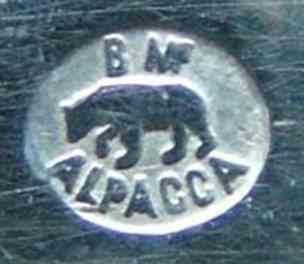 |
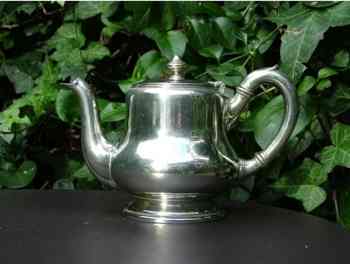 |
No.1, 1880-1891, 3.0 x 3.6 mm
|
30 cl Alpacca teapot from France
|
The next Berndorf Alpacca mark (No.2) was applied in 1891-1930. It is rather common, I have four
pieces with this mark, including the 40 cl teapot shown below. The mark No.2 represents an
oval of 3.6 x 4.6 mm size (the mean value of four measurements),
bearing the lettering "BERNDORF ALPACCA" and the horizontal dots
separating these two words. Inside the oval there is a profile
of a walking bear looking down similar to that of No.1.
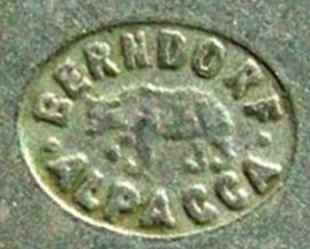 |
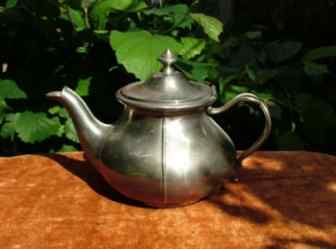 |
No.2, 1891-1930, 3.6 x 4.6 mm
|
40 cl Alpacca teapot from Hungary
|
The third Berndorf Alpacca mark (No.3) was found on a 15 cl
creamer, which was issued between 1930 and 1938. This mark is
similar to No.2 with the exception of the larger size (4.5 x 6.5
mm) and the different profile of the bear: fatter, with both
ears visible and looking forward. This mark is also quite rare.
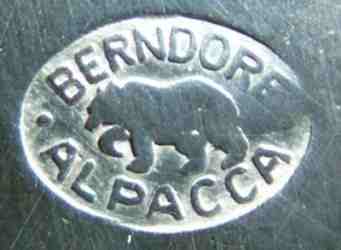 |
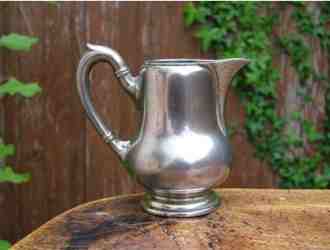 |
No.3, 1930-1938, 4.5 x 6.5 mm
|
15 cl Alpacca creamer from Hungary
|
Two last Berndorf Alpacca marks in my collection, No.4 and
No.5, were issued in 1938-1945, after the death of Arthur Krupp.
Therefore, they contain the side wording "KRUPP" and "BERNDORF",
which appear to the left and to the right of the oval. I was
able to distinguish two types of oval: with a flat bear profile
(No.4) and with a relief one (No.5). The sizes of the ovals are
also different, 3.5 x 4.5 mm and 2.8 x 3.5 mm for marks No.4 and
No.5, respectively. The profiles of bears were also slightly
modified in comparison with No.3.
 |
No.4, 1938-1945, 3.5 x 4.5 mm, flat bear
profile
|
 |
No.5, 1938-1945, 2.8 x 3.5 mm, relief bear
profile
|
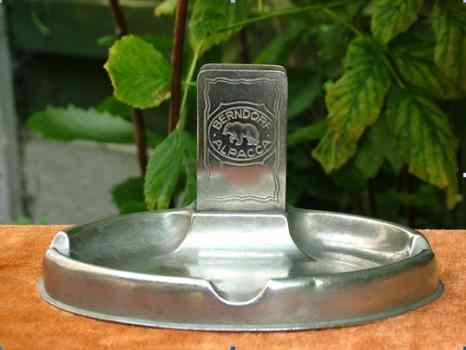 |
Alpacca ash-tray from Hungary, bearing mark
No.5
|
The first Berndorf Alpacca Silber II mark (No.6) was introduced around 1880 and used fifty (!)
years until 1930. Such a mark was
found on the bottom of a silver-plated 30 cl teapot. Inside the
rhombus with the vertical diagonal of 3.5 mm long there are two
letterings: "BMF" (with the "M" and "F" letters being fused) and
"ASII" (which means Alpacca Silber II) and a profile of a
walking bear similar to that on mark No.2.
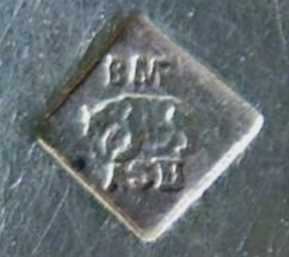 |
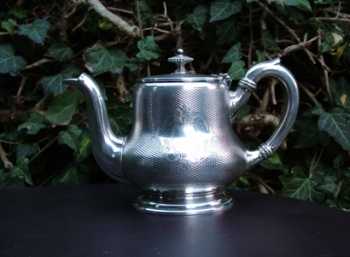 |
No.6, 1891-1930, 3.5 mm diagonal
|
Silver-plated 30 cl teapot from Karlsruhe
|
The second (No.7) and the third (No.8) Berndorf Alpacca
Silber II marks were introduced in 1930 and used until 1938.
They both use the rhomb with the vertical diagonal of 6.1 mm and
the bear profile similar to that on mark No.3. The difference
between the two marks is the additional circle of 1.9 mm in
diameter bearing the lying "E" letter in the case of No.8. The
presence of this additional circle testifies that the item with
such a mark was issued by the Esslingen branch of Berndorf
factory (Esslingen am Neckar, Baden-Wuerttemberg, Germany).
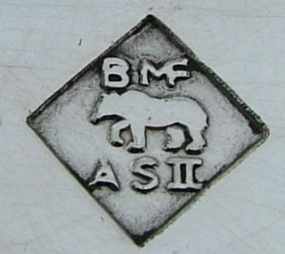 |
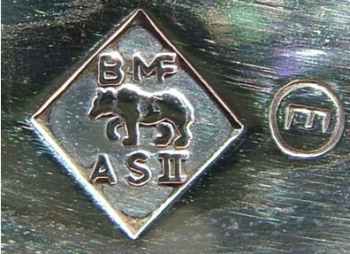 |
No.7, 1930-1938, 6.1 mm diagonal
|
No.8, 1930-1938, 6.1 mm diagonal, "E" letter
|
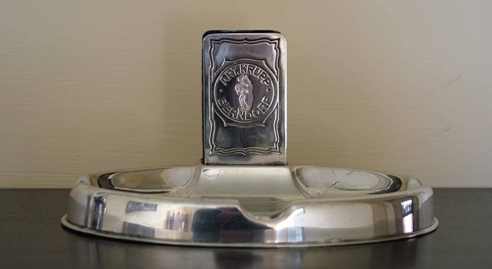 |
Alpacca Silber II ash-tray from UK, bearing
mark No.8
|
I believe that my list of marks used by the Berndorf factory
for low-quality items is far from being completed, i.e., the
ASII marks for the 1938-1945 period are absent. But for a
passionate collector the absence of something (marks or rare
pieces) in a collection is a challenge, which drives his/her
life.
BIBLIOGRAPHY
- Ingrid Haslinger, Tafelkultur Marke Berndorf, Das Niederoesterreichische Erfolgsunternehmen
Arthur Krupps (Ketterl Verlag, Wien, 1998), pp.1-174, (in German).
- Dedo von Kerssenbrock-Krosigk and Claudia Kanowski, Modern Art of Metallwork (Berlin: Broehan Museum, 2001), 1-598.
- Musterbuch ueber Tafelgeraete in Alpacca-Silber I, Alpacca-Silber II und Alpacca, Unversilbert
(Berndorfer Haus, Berlin, 1928), pp.1-53, (in German).
- Waltraud Neuwirth, Bluehender Jugendstil Oesterreich, Band 2: Firmen und Marken [Art Nouveau
in Blossom - Austria, Vol. 2: Companies and Marks]. Vienna: Selbstverlag Dr. Waltraud Neuwirth, 1991,
1-288 (in German).
- David N. Nikogosyan, 2008, Marks of Silverplated Hollowware Made by the Berndorf Metalware
Factory in Austria, Silver Magazine, Vol.40, No.3, pp.3-41; Correction, Silver Magazine, Vol.40, No.4,
p.11. Copies of these articles can be ordered through Silver Magazine "Back Issues &
Index" service, available at www.silvermag.com
- Wikipedia, Die freie Enzyklopaedie. "Ernst August Geitner".
http://de.wikipedia.org/wiki/Ernst_August_Geitner, 2007 (in German).
- Wikipedia, Die freie Enzyklopaedie. "Neusilber".
http://de.wikipedia.org/wiki/Neusilber, 2008. (in German).
further BMF marks and information:
Marks of Berndorf Metalware Factory
Dr. David N. Nikogosyan
- 2008 -

www.silvercollection.it |
This is a page of A Small Collection of
Antique Silver and Objects of vertu, a 1500 pages richly illustrated website offering all you need to know about
antique silver, sterling silver, silverplate, Sheffield plate, electroplate silver,
silverware, flatware, tea services and tea complements, marks and hallmarks, articles,
books, auction catalogs, famous silversmiths (Tiffany, Gorham, Jensen, Elkington),
history, oddities ...
HOME - SITE MAP - SILVER DICTIONARY - COOKIES CONSENT AND PRIVACY
OTHER ARTICLES ABOUT: ANTIQUE SILVER
SILVER PLATE
ENGLISH SILVER
FRENCH SILVER
|
|
|















